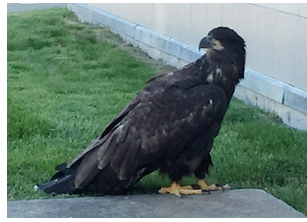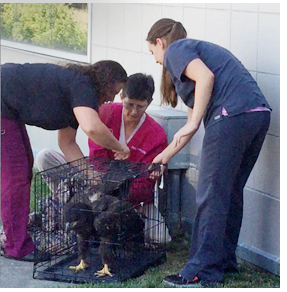
District 1 helps save wandering, starving baby bald eaglet
The District 1 office in CDA helped save a baby bald eaglet July 31, connecting the starving, perhaps stunned young raptor with the Prairie Animal Hospital and ultimately the Birds of Prey Northwest for rehabilitation.
The saga began with the young bird wandering in front of the district office building around 9 a.m. that morning, certainly starving and perhaps disoriented. A heavy sheet was put over the eaglet to subdue it until rescuers from the animal hospital could notify the birds of prey center to come retrieve the bird.
The dazed bird is pictured to right prior to capture.
Janie Veltkamp, a raptor biologist with the Birds of Prey Northwest, mentioned that initial efforts focused on helping the bird, which had likely come from the Heyburn area, regain some of the weight it had lost. She said a bird of that size and age — the two-month old raptor stood more than two feet tall, with a six-foot wingspan — normally weighs about 11 pounds, but had shrunk to less than nine pounds.
She said the bird had no bone fractures, but observers were concerned that the bird had developed visual problems, leading to disorientation and the lack of ability to effectively hunt.
“The bird has shown problems locating and pinpointing its perch, and unless food is right in front of it, the bird has trouble interpreting visual cues,” Veltkamp said.
Veltkamp said the bird is most likely a female, which are bigger than males, and the desired outcome would be to release it into an area that already contains many mature bald eagles, such as near Heyburn State Park. Of course, if the bird is shown to be nearsighted or farsighted, those visual problems may mean it does not go back to the wild, but instead is used by the center for educational outreach activities, such as school assemblies.
“We should know the outcome by Sept. 15,” Veltkamp said. At that point the bird should have regained the lost weight and vision problems, if any, will be identified. 
Birds of Prey Northwest helps rehabilitate approximately 150 birds each year, according to Veltkamp.
Pictured to left: A veterinarian and two veterinarian technicians from the animal hospital help corral the bird for transport to the raptor rehab center.
Published 08-14-15